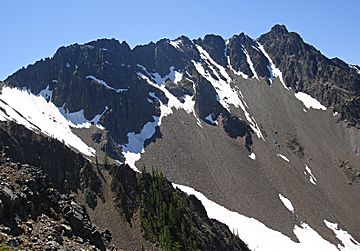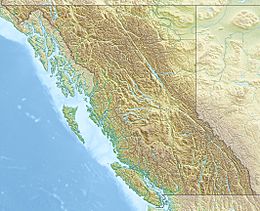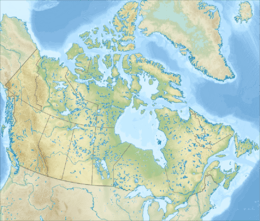Frosty Mountain facts for kids
Quick facts for kids Frosty Mountain |
|
|---|---|

Northeast aspect of Frosty Mountain
|
|
| Highest point | |
| Elevation | 2,426 m (7,959 ft) |
| Prominence | 451 m (1,480 ft) |
| Parent peak | Castle Peak |
| Geography | |
| Location | Manning Provincial Park British Columbia, Canada |
| Parent range | Hozameen Range Canadian Cascades |
| Topo map | NTS 92 H/2 |
| Type of rock | Metasedimentary rock |
| Climbing | |
| First ascent | 1904 Sledge Tatum, George Loudon Jr. |
| Easiest route | class 2 Scrambling via north ridge |
Frosty Mountain is a tall mountain in southwestern British Columbia, Canada. It stands 2,426-metre (7,959-foot) high. It's about 4 km (2 mi) south of Lightning Lake. The mountain is also close to the Canada–United States border.
Frosty Mountain is the tallest peak in E. C. Manning Provincial Park. It's part of the Hozameen Range, which is a smaller part of the larger Cascade Range. There's also a slightly lower peak nearby called Frosty Mountain East (2409 m). The name Frosty Mountain became official on March 31, 1924.
The first people to climb Frosty Mountain were Sledge Tatum and George Loudon Jr. They reached the top on September 2, 1904. They were part of a group surveying the Canada–United States border. Water from the mountain flows into Frosty Creek and other streams that feed the Similkameen River.
How Frosty Mountain Formed
The Cascade Range mountains, including Frosty Mountain, began forming millions of years ago. This happened during a time called the late Eocene Epoch. The North American Plate was slowly moving over the Pacific Plate. This movement caused a lot of volcanic activity.
Also, small pieces of the Earth's crust, called terranes, came together. This process helped create the North Cascades about 50 million years ago. Frosty Mountain itself is made of metasedimentary rock. This rock was pushed up vertically from an ancient ocean called the Methow Ocean.
During the Pleistocene period, which started over two million years ago, glaciers played a big role. Huge sheets of ice moved across the land many times. As they moved, they carved out the landscape. This left behind rock and debris. The "U"-shaped valleys you see today were formed by these glaciers.
Over time, the land was also pushed up (orogeny) and broken apart by faults. These forces, combined with the glaciers, created the tall peaks and deep valleys of the North Cascades.
Mountain Weather
Most weather fronts start over the Pacific Ocean. They then travel east towards the Cascade Mountains. When these weather fronts reach the North Cascades, the tall peaks force the air upwards. This process is called Orographic lift.
As the air rises, it cools down and drops its moisture. This moisture falls as rain or snow onto the Cascades. Because of this, the western side of the North Cascades gets more rain and snow than the eastern side. This is especially true during winter.
In winter, the weather is often cloudy. However, during summer, high-pressure systems build up over the Pacific Ocean. These systems often bring clear skies and little to no cloud cover.
Images for kids
-
View from Frosty Mountain East with Frosty Mountain to right and Castle Peak to the left





